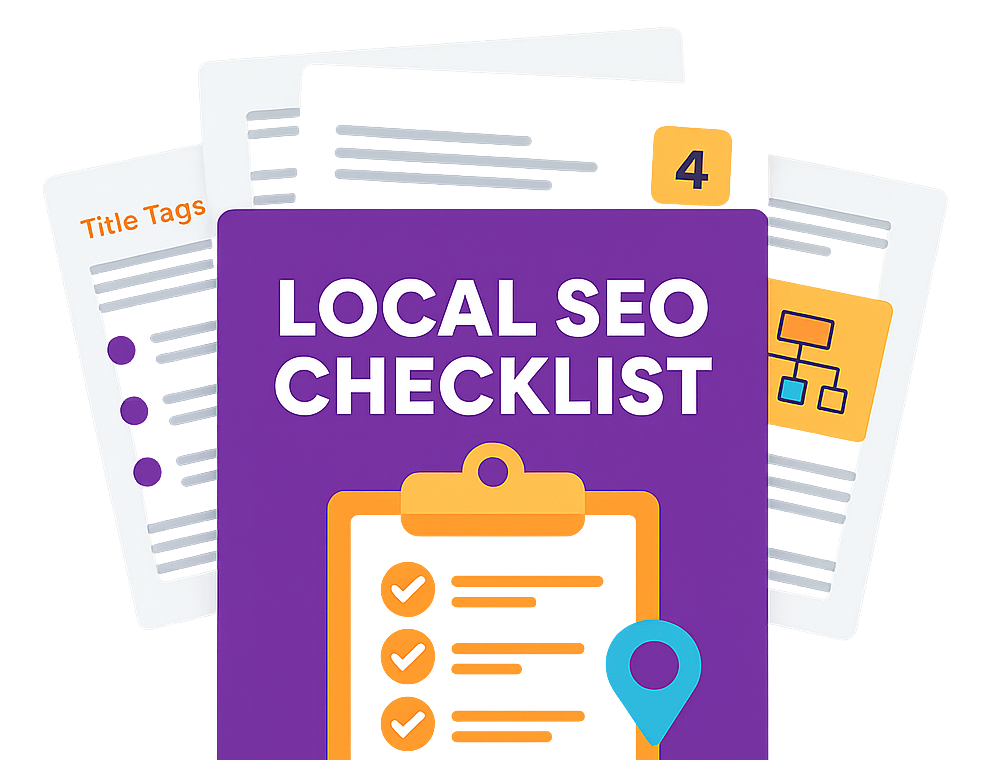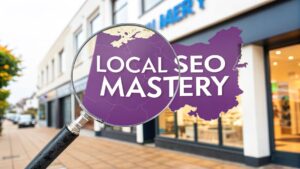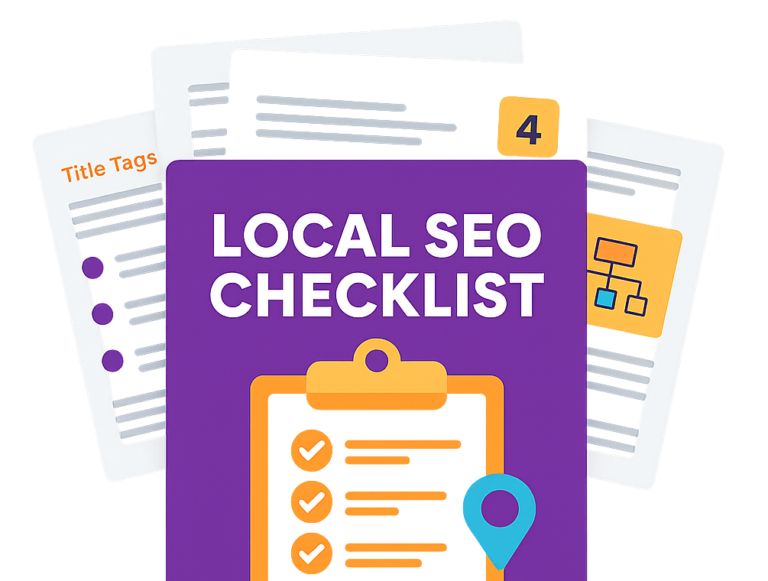To write a truly great meta description, you have to get inside the searcher’s head. It’s a delicate balance of persuasive copywriting and a deep understanding of what they’re looking for, all wrapped up in a short advert that makes them choose your link.
I always tell clients to think of it as their digital shop window. You've got a split second to make your display compelling and relevant enough to draw people inside.
The True Purpose of Meta Descriptions in UK SEO
Let's clear the air on something straight away: meta descriptions aren't a direct ranking factor for Google. That's a common myth. Their real power is in persuasion—convincing a real person to click your result instead of the nine others on the page.
It's your sales pitch, plain and simple. You've got a fleeting moment to grab someone's attention and show them that your page has the answer they've been searching for.
Why They Matter More Than You Think
A well-crafted meta description is so much more than a simple summary of your page’s content. It plays a huge psychological role in how a user decides what to click.
- It Builds Instant Trust: A clear, professional description sends a strong signal. It says you're an authority and that your content can be trusted before a user even lands on your site.
- It Speaks Directly to Search Intent: This is your first, and often best, chance to prove you get what the user needs and that you have the solution right there on the page.
- It Boosts Click-Through Rate (CTR): A genuinely compelling description gets more clicks. More clicks mean a higher CTR, which is a big green flag for Google. While it's not a direct ranking signal, a strong CTR is a cornerstone of successful search engine optimisation. You can find more strategies for improving your search performance in our guide on how to rank higher on Google.
To help you visualise the difference, here's a quick breakdown of what separates a winning meta description from one that gets ignored.
Anatomy of a High-Performing Meta Description
| Component | What to Do (Best Practice) | What to Avoid (Common Mistake) |
|---|---|---|
| Length | Keep it between 120-155 characters. This prevents it from being cut off on most devices. | Writing too little (wasted opportunity) or too much (gets truncated). |
| Keyword | Include your primary keyword naturally, ideally near the start. | "Keyword stuffing" or forcing keywords where they don't belong. |
| Value Proposition | Clearly state the benefit. What problem will you solve or what question will you answer? | Vague, generic summaries that don't offer a clear reason to click. |
| Call-to-Action | Use a soft, inviting CTA like "Learn how," "Discover more," or "Find out." | Aggressive sales language or no CTA at all. |
| Tone of Voice | Match the tone of your brand and the page content. Be helpful and engaging. | A robotic or overly formal tone that doesn't connect with the reader. |
This table is a great starting point, but there's another player in this game you need to be aware of.
Google's Role in Your Descriptions
Here’s a dose of reality: Google won’t always use the meta description you've painstakingly written. In fact, a UK-focused analysis I came across found that Google rewrites around 63% of them.
So what's going on here? Google's algorithm sometimes decides it can create a more relevant snippet by pulling text directly from your page that better matches a user's specific search query. Don't take it personally. Instead, see it as a valuable insight into what your audience is really looking for.
This is exactly why brilliant, well-structured on-page content is just as crucial as the meta description itself. When you fill your page with clear, helpful, and relevant copy, you’re essentially giving Google a selection of high-quality snippets to choose from if it decides to go off-script.
It's a win-win. Your message stays on point, giving you an indirect but powerful SEO advantage even when your original description isn't used. Your job is to write a fantastic meta description, but also to make sure the rest of your page is full of equally compelling alternatives.
Writing Compelling Copy That Earns the Click

This is where the rubber meets the road. Crafting a great meta description is a perfect blend of persuasive copywriting and smart SEO. It's your one shot to speak directly to someone looking for an answer and convince them your page is the one they need to click.
Think of it less as a summary and more as a tiny, powerful advert for your content. A bland, robotic description will get scrolled past without a second thought. But one that connects with a user's problem? That’s what earns the click.
Adopt an Active Voice
One of the quickest ways to make your copy more compelling is to switch to an active voice. It’s direct, clear, and makes your content feel more dynamic. Instead of just describing what’s on the page, tell the user what they can do, find, or learn.
- Passive voice: "Information on garden shed organisation can be found here."
- Active voice: "Discover simple ways to organise your garden shed and reclaim your space."
See the difference? That small tweak puts the user in the driving seat and makes the benefit feel immediate. You’re extending an invitation, not just slapping a label on a page.
Answer the 'What’s In It for Me?' Question
Every single person searching on Google has a problem they want to solve. Your meta description has to show them, in just a few seconds, that you hold the solution. Don't just list what your page is about; highlight the benefit of clicking.
What makes your content or product special? Is it faster, more comprehensive, or easier to follow? Do you have a unique perspective they won't find elsewhere? This is your unique selling proposition (USP), and it needs to be front and centre.
A strong meta description focuses entirely on the user's gain. It promises a specific outcome—whether that's learning a new skill, solving a frustrating problem, or finding the perfect product. Always frame your copy around the value you provide.
For instance, "We sell handmade leather bags" is okay, but it’s not compelling. Try this instead: "Shop durable, handmade leather bags with a lifetime guarantee. Free UK delivery on all orders." The second version screams quality, trust, and value—making it far more persuasive. Getting these details right is a crucial part of any good content plan, something we explore further in our guide to content marketing best practices.
Weave in Your Keyword Naturally
Keyword stuffing has been dead for years, but that doesn't mean you should ignore your target keyword. Including it is still vital. It confirms to both Google and the user that your page is relevant to what they searched for. Plus, Google often bolds the search term in the description, which helps your result pop on the page.
The trick is to make it sound completely natural, not shoehorned in. A good rule of thumb is to place it near the beginning, where it has the most impact.
Good Example (Keyword "how to write meta descriptions"):
"Learn how to write meta descriptions that drive clicks. Our guide offers practical tips, UK examples, and simple frameworks to boost your SEO performance."
This works because the keyword flows with the sentence, while the rest of the description promises clear, actionable value. It tells the reader exactly what they’ll get and builds confidence that their click won’t be wasted.
Getting the Technical Details Right

It’s easy to get caught up in the creative side of writing a meta description, but if you don't nail the technical bits, all that great copy might never see the light of day. Getting these foundational elements right ensures search engines can actually read and display your hard work.
Think of these as the technical guardrails for your creativity. It’s a common oversight, but ignoring them can completely undo your copywriting efforts.
Master the Character Limit
First things first: length. This is probably the most fundamental rule of all. While Google technically measures by pixel width, not characters, a solid rule of thumb is to aim for around 150-160 characters.
Why is this so important? Because if your description is too long, it’ll get cut off mid-sentence with an unappealing "…". A truncated message not only looks unprofessional but can also completely neuter your call to action. Keeping it concise is key.
Ensure Every Page Is Unique
Here’s one of the biggest technical mistakes I see: using the same meta description across multiple pages. Every important page on your website needs its own, uniquely crafted description.
This isn’t just about ticking a box. It matters because:
- It Prevents Confusion: Unique descriptions tell Google that each page has distinct content and value, which helps it index your site more effectively.
- It Enhances User Experience: Searchers get a specific, relevant preview for every page, massively increasing the odds they’ll click on the right one.
- It Avoids 'Duplicate Content' Penalties: Search engines aren't fans of duplicated content, and this applies to metadata too. Staying on top of this is a core part of good site health, something we cover in our technical SEO audit checklist.
I always tell clients to think of it this way: you wouldn't run the exact same advert for two different products. Give each page the individual attention it deserves. Start with your most important pages—core services, key products, and high-value blog posts.
How to Implement Your Description
Thankfully, adding your meta description is usually pretty straightforward. Most content management systems (CMS) like WordPress have made this incredibly simple, especially if you’re using an SEO plugin.
With tools like Yoast SEO or Rank Math, you'll find a clear field for it right in the page editor. Just paste your description into the "Meta Description" box, and the plugin will automatically add the correct code to your page’s <head> section. No coding required.
As a final tip, don't be afraid to use special characters or emojis to add a bit of visual flair—but use them sparingly. A well-placed tick (✓) or star (⭐) can make your snippet pop in a crowded search results page. Overdo it, though, and it just looks spammy. It’s a small detail that can make a surprisingly big difference.
Optimising Descriptions for Local UK Searches

For any business with a physical presence or a defined service area, weaving local signals into your meta descriptions isn't just a good idea—it's essential. It’s no longer enough to be the best; you need to be the best nearby. This is your prime opportunity to show both Google and searchers that you’re the local solution they need.
Focusing your copy on specific UK regions, towns, or even postcodes can give you a serious edge. It helps you stand out from the national chains and connect directly with people who are ready to buy or visit.
How to Weave in Local Signals
The trick here is to be natural. Simply stuffing a list of town names into your description looks spammy and will put people off. Instead, your goal is to integrate these local cues in a way that feels genuinely helpful.
Think about how you search. You’d probably type in "plumbers in Cambridge" or "best Sunday roast near Peterborough." Your description needs to speak that same language.
- State your service area clearly: "Your friendly, reliable electrician serving Cambridge and the surrounding villages."
- Showcase local expertise: "The leading estate agent in Cambridgeshire, with over 20 years of local market experience."
- Use a landmark or address: "Find our award-winning cafe just minutes from Ely Cathedral. Pop in today!"
These examples instantly answer the searcher's most important question: "Is this business near me?" Of course, a well-managed Google Business Profile is a huge part of this, reinforcing your location across the board. For a deeper dive, check out our guide on Google My Business optimisation.
Keeping Up with Modern Search Habits
The way people look for things is constantly changing, especially on mobile. Voice search and "near me" queries aren't just for techies anymore; they're how millions of people find what they need every day. This means our meta descriptions have to adapt.
This shift is particularly obvious in the UK, where a staggering 72% of consumers use voice assistants for local searches, and 76% use 'near me' in their queries. Your meta description is your first line of defence in capturing this highly motivated traffic. You can get more details from this UK search statistics report.
Expert Tip: Think of your local meta description as a direct answer to a voice search query. If someone asks their phone for an "emergency locksmith in St Ives," a description starting with "24/7 emergency locksmith in St Ives, Cambridgeshire" is a perfect, immediate response.
This approach does more than just cater to new habits. It aligns your search snippet's promise with what's actually on your page. When a user clicks through and immediately sees their location mentioned, it confirms they're in the right place, building trust and making them far less likely to hit the back button.
A Framework for Testing and Improving Your Descriptions
Let's be clear: writing a meta description isn't a "set it and forget it" job. To really get ahead, you need a solid process for continuous improvement. What works brilliantly today might fall flat in six months, so constantly refining your approach is the key to long-term success.
This means you have to go beyond just writing and hitting publish. Having a framework for testing, analysing, and tweaking your descriptions is what separates the good from the great in SEO.
Monitoring Your Click-Through Rate
Your best friend here is Google Search Console. It’s a free and incredibly powerful tool that shows you exactly how your pages are performing in search results. The metric you need to obsess over is your click-through rate (CTR).
A low CTR on an important page that’s getting plenty of impressions is a massive red flag. It’s telling you that people see your result, but something is putting them off clicking. More often than not, the culprit is a weak or uninspired meta description.
My advice is always to start with your most valuable pages. Dive into Search Console and find your top 10-20 pages by impressions. If a page is getting thousands of views but has a CTR below 2%, it’s a prime candidate for a meta description rewrite.
Setting Up Simple A/B Tests
Once you've flagged an underperformer, it's time for a simple A/B test. All this involves is creating a new, alternative meta description to run against the original.
The trick is not to change too much at once. If you want clear results, test one element at a time. For instance, you could:
- Test a new call-to-action: Swap out a generic "Learn more" for a punchier "Get your free quote".
- Test a different value proposition: Instead of focusing on a feature, try highlighting a problem you solve.
- Test the tone: Experiment with a more direct, urgent tone versus a softer, more informative one.
Let each version run for a good few weeks to collect enough data, then pop back into Search Console. If the new description has a higher CTR, you've got a winner. This cycle of testing and learning is how you turn decent SEO into exceptional SEO.
This handy visual guide breaks down the essential checks I run through for any meta description review.

Following this process helps ensure your descriptions stay concise, focused, and unique – the cornerstones of effective metadata.
The Value of Regular Audits
This proactive approach is really catching on. I'm seeing more and more UK businesses realise that updating their metadata at least quarterly is vital for staying relevant and maximising their CTR. After all, well-optimised descriptions can drive a serious increase in organic traffic, which translates directly into more leads and revenue. You can find more on the importance of meta optimisation for UK businesses in this guide.
By scheduling regular content audits, you keep your metadata fresh, relevant, and perfectly aligned with your business goals.
Common Meta Description Mistakes to Sidestep
Even seasoned marketers can slip up when writing meta descriptions. It happens. Knowing what not to do is honestly just as important as knowing what you should be doing. One simple mistake can make your carefully written copy completely invisible, costing you those all-important clicks.
Think of it as the final check before you hit publish. Dodging these common blunders ensures your descriptions are always working for you, not against you. Let's look at the pitfalls I see most often and how to avoid them.
Promising What Your Page Can't Deliver
This is the cardinal sin of copywriting, and it’s a surprisingly common one. Your meta description is a promise. If you promise the "ultimate guide" but deliver a flimsy, 300-word overview, people will click away in seconds.
That kind of behaviour leads to a high bounce rate, which is a major red flag for Google. It tells the search engine that your page didn't meet the searcher's needs, and that can hurt your rankings over time.
Your meta description has to be an honest preview of what’s on the page. Be authentic. It builds trust and makes people want to stick around, rather than bouncing back to the search results in frustration.
Writing Vague, Generic Copy
A description that could fit any one of your competitors is a totally wasted opportunity. Phrases like "Click here to learn more" or "This page has information about our services" are just filler. They don't create urgency, and they certainly don't communicate any unique value.
You’re fighting for attention on a very crowded page. Your description has to be specific and compelling to get noticed.
- Generic: "We offer digital marketing services for businesses."
- Specific: "Expert SEO services in Cambridge to boost your rankings. Get a free, personalised SEO health check in 24 hours."
See the difference? The second one is packed with specific benefits and a clear call-to-action. It's infinitely more persuasive.
Forgetting There's a Human on the Other Side
This is probably the biggest mistake of all: getting so wrapped up in keywords that you forget a real person has to read this thing. Keyword stuffing is a relic of the past; it just makes your copy sound robotic and clunky.
Always write for people first. Then, weave your keywords in where they make sense. A description that speaks directly to a person's problem, uses an active voice, and clearly answers "what's in it for me?" will win the click every single time. Your goal is to convince a person, not just show a keyword to a bot.
Your Questions, Answered
Does Every Single Page Really Need a Unique Meta Description?
In a perfect world, yes. Think of it this way: your homepage, main service pages, and cornerstone blog posts are your digital storefronts. You'd want each one to have a custom, compelling sign in the window, right? That’s what a unique meta description does.
Now, let's be realistic. If you're running a massive e-commerce site with thousands of product pages, writing one for every single item isn't just impractical—it's nearly impossible. In those cases, a well-thought-out programmatic template can do the heavy lifting for less critical pages. But for the pages that truly matter to your business, individual attention is non-negotiable. It’s how you stand out and avoid messy duplication issues with search engines.
What Happens If I Just Don't Bother Writing One?
If you leave the meta description field blank, you’re essentially handing the keys over to Google. The search engine will scan your page and pull a snippet of text it thinks is relevant to the user's query.
Sometimes, it does an okay job. But more often than not, you'll end up with a clunky, out-of-context sentence fragment that does nothing to sell your page. Writing your own means you control the message, ensuring it’s sharp, persuasive, and aligned with your goals. It’s almost always going to be more effective than a snippet Google cobbles together on the fly.
Should I Squeeze My Brand Name into the Description?
This one’s a classic "it depends" scenario. If your brand carries a lot of weight and inspires trust in your industry, then absolutely—tucking it in at the end can be a smart move. People recognise the name and are more likely to click.
However, remember you're working with very limited real estate. If space is tight, those characters are often better spent on a stronger call-to-action or a more powerful value proposition. Always ask yourself: what’s going to be more persuasive for someone scanning the search results? The answer will guide your decision.
Ready to turn those clicks into customers? Bare Digital offers expert SEO services to get your meta descriptions and overall strategy working harder for your business. Start with a free, no-obligation SEO health check today. Get Your Free SEO Proposal








